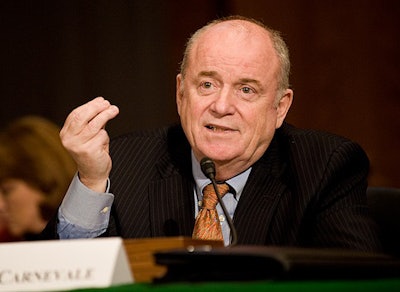 Anthony Carnevale, lead author of the study, says that, while U.S. higher education is color blind in theory, it “in fact operates, at least in part, as a systematic barrier to opportunity for many African-Americans and Hispanics.”
Anthony Carnevale, lead author of the study, says that, while U.S. higher education is color blind in theory, it “in fact operates, at least in part, as a systematic barrier to opportunity for many African-Americans and Hispanics.”
In Separate and Unequal: How Higher Education Reinforces the Intergenerational Reproduction of White Racial Privilege, co-authors Dr. Jeff Strohl and Dr. Anthony Carnevale report that White overrepresentation in the nation’s most elite and competitive colleges has been increasing even as the White percentage of college-age students declined from 69 percent to 57 percent between 1995 and 2009. Strohl noted that, at the same time, minority access to the U.S. postsecondary system has grown dramatically.
“The good news is that African-Americans and Hispanics scored big gains in access to postsecondary education. The bad news is that both groups are losing ground in their move up to the most selective colleges relative to their growing population shares,” Separate and Unequal states.
Since 1995, more than 80 percent of new White enrollments have been at the top 468 colleges and more than 70 percent of new African-American and Hispanic enrollments have resulted at open-access two-year and four-year colleges. As a result of these patterns, the American “postsecondary system is more and more complicit as a passive agent in the systematic reproduction of White racial privilege across generations,” the study states.
Carnevale, the CEW director, said in a statement that, while U.S. higher education is color blind in theory, it “in fact operates, at least in part, as a systematic barrier to opportunity for many African-Americans and Hispanics, many of whom are college-qualified but tracked into overcrowded and underfunded colleges where they are less likely to develop fully or to graduate.”
The co-authors find that the dual postsecondary system has been responsible for a significant loss of talent and opportunity among both minorities and low-income students. More than 240,000 high school students annually, graduating in the top half of their senior class and coming from families in the bottom half of family income, do not attain either two- or four-year degrees within eight years following high school graduation. Study data reveal that roughly one in five, or about 62,000, of these high-performing, low-income students are African-American or Latino.
In addition, there are more than 111,000 African-Americans and Latinos who graduate from high school each year in the top half of their class but do not attain a two- or four-year degree within eight years. The study contends that, if these students had attended one of the top 468 colleges and graduated at similar rates, 73 percent would have graduated.
“We’re talking about this huge crisis in American competitiveness and we keep talking about problems of readiness, which are extremely important. But we’re missing the fact that many ready students are getting missed in the system,” Strohl told Diverse.
The impetus for the study comes largely from Carnevale’s and Strohl’s interest in questions of inequality and education, according to Strohl. “The main author, Tony Carnevale, has been doing work in this since about 1995 when he was at the Educational Testing Service (ETS) and it follows out of a longstanding concern about biases in postsecondary outcomes,” Strohl said.
“The interest is really driven by our underlying American ideal that education is meant to be the great equalizer,” he noted.
Dr. Walter Kimbrough, president of Dillard University, said the study’s findings represent an opportunity for leaders and advocates of historically Black colleges and universities. He noted that HBCUs stand much to gain by attracting the high-performing, low-income Black students who have been heading into community colleges and the open-access, non-HBCU four-year institutions.
“Those students would be much better off going to a four-year HBCU because there’s research” that says Black students are four times more likely to earn a college degree starting at an HBCU rather than a two-year school, Kimbrough said.
“I think every HBCU president [utilizing] their local paper, along with UNCF and NAFEO, should be writing op-ed pieces and trying to get as much press on this report because it is really a strong validator for what we do,” he added.


















